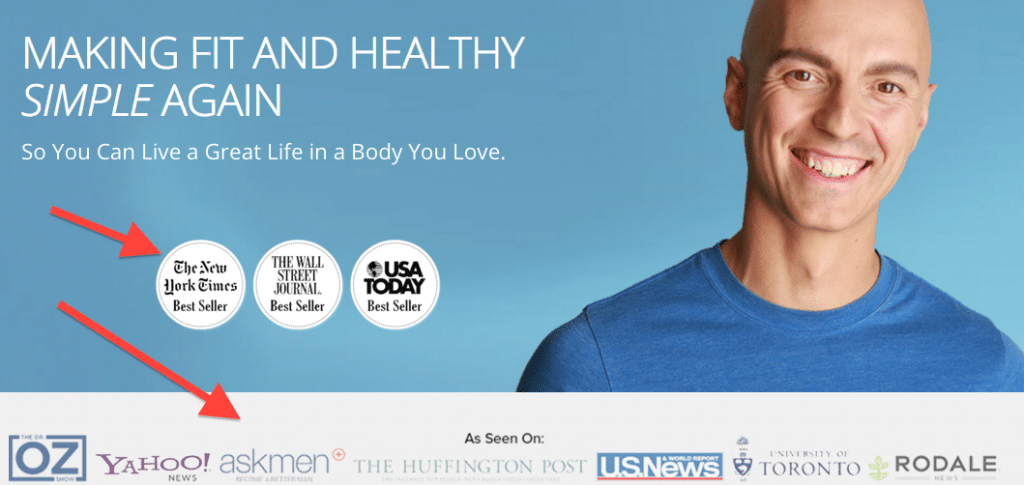Despite the title of this post, I’m not going to talk about customer acquisition tactics here.
What I will do though is something far more powerful that will serve you for years to come. Here, you’re going to learn how to INFLUENCE people so that they do what you want them to do.
Now, don’t mistake this for manipulation – that’s not what I’m talking about here. What I’m about to show you are 6 ways to motivate human beings to take action. And specifically how to move people from not knowing you to wanting to do business with you.
After all, we’re in the game of helping others improve their health.
Thus, much of what we do revolves around being able to INFLUENCE others to take action in a direction that is in their best interest.
Call it selling, marketing, or teaching – it’s all the same to me.
At the core of it all is being able to move someone to a bigger future. And that can’t happen if you don’t understand what makes us humans tick.
While technology evolves exponentially and continues to overwhelm us with more and more options, one thing remains the same:
Human psychology (and thus behavior).
In this post, I’m going to walk you through 6 very important psychological triggers you need to know about (and use) in your business to truly serve your audience.
These are not principles that fade with time. As long as human beings have the same limbic brains and prefrontal cortexes, these “triggers” will work and help you and your customers in the process.
Because remember:
At the end of the day, it doesn’t matter how good your product is. If nobody knows about and nobody uses it, it’s not helping anybody.
I’ll give you specific examples of when to use them these triggers, how to use them, and how not to use them. So let’s jump in:
1. Scarcity
Perhaps the first and most important way to get more clients is by using scarcity.
Since the beginning of time, if you tell somebody you’re taking something away, they immediately want it more.
For example, if you tell somebody that a special deal you are offering is only available until tonight at midnight, and if they miss out, they’re going to be paying full price, you’re creating a scarcity (or urgency).
There’s no greater motivation than that.
As human beings, we’re more motivated by the fear of loss or the fear of pain —which, in this case, would be losing out on something — than we are motivated by the potential gain of something.
When you can use that element of scarcity, you put yourself in a very powerful position.
You have to be very careful not to misuse this concept, however.
You may have seen web pages that say: “Buy this report now. The first 500 copies are $7, and after that, the next 500 copies are $17. The following 1000 copies will be priced at $27.”
But if you visit that same sales page two years from now, you’d still see the same exact offer.
That’s not a very ethical way of marketing, and I encourage you to move away from that approach.
Why? Because it’s not authentic.
Let me give you an example of how to use that same offer in a way that’s real and authentic.
Instead of setting up the fake, “Here are the different tiers of prices at different copies” offer, you take action so that the offer is real.
There are different plugins for your website that will make that possible. For instance, Page Expiration Robot is a WordPress plugin that allows you to create that type of scarcity on a per-product-purchase basis or per-time basis.
The plugin costs around $20, but it’s amazing. We use it on a number of our websites.
If we’re running a $7 promotion and say it’s going to expire Friday at midnight and there’s a countdown timer on that page, what Page Expiration Robot will do is set up a different URL that it automatically directs to after the timer expires.
This is important because if you tell potential customers to go to your sales page and they see a countdown timer to an expiration time, and then your offer doesn’t really expire, you essentially train them not trust what you’re saying.
That is far more devastating than any other benefit you may derive from any kind of scarcity sale.
If you’re going to use scarcity, make sure it’s real and legit.
Put a countdown timer on your page with a clear expiration date and time.
At that expiration time, redirect that page to the normal price of the product, so people no longer have access to the sale.
If you want to run that sale promotion again, you are free to do so.
This way, they’ll know you mean business because when the timer expired, the page was gone, and the offer was off the table.
I can tell you from personal experience, on the final day when we announce that a discount is going away, we always see pretty much a doubling of sales.
If you’re not using the psychological trigger of scarcity, you are losing out big-time.
Here’s the thing: You want people to take action now, not in a week from now, not three months from now.
We understand not everyone is ready to buy now, but if people need to be pushed over the edge a little bit to use something you offer that will of value to them, you need to do what you can to make them take that action.
There are numerous ways you can use scarcity, but just understand that you don’t want to have an offer on the table indefinitely.
You want to have some type of scarcity that is real, authentic, and not some ploy just to get people to take action.
2. Social Proof
This second trigger — social proof — actually plays in nicely with scarcity to a certain degree if you use it well.
People will try products, programs or new things if they know that other people are doing the same things.
Let me give you an example of social proof when it comes to restaurants or nightclubs. If you walk to a restaurant and you see it’s completely empty inside, are you really compelled to want to eat there? Probably not.
If you go to a nightclub and there’s a huge lineup around the block, it’s most likely a pretty happening nightclub or bar, and you will want to see what all the hubbub is about. That is social proof.
You don’t want to be made to look like a fool. You want to do things that are proven, that others have declared as awesome. That’s why social proof is really important.
One way to incorporate social proof into your marketing is through Facebook.
If you have a good following on Facebook, using a Facebook widget on your website will show visitors you’re not just some flake who doesn’t know what they’re talking about.
That being said, if you only have one hundred fans on Facebook, I wouldn’t recommend you use the widget — you’d want to build up your fan base first.
Nonetheless, you want to find ways to incorporate social proof.
Probably the most powerful way online is to use testimonials.
I’m going to give you a really sneaky ninja trick here that I didn’t see many people using.
We all know that testimonials — success stories — are the epitome of social proof.
They’re going to put people over the edge in terms of having them commit to buying something because they want to see if what worked for someone else will work for them.
If you’re selling something, it’s one thing to have a bunch of experts endorse it, but it’s far more powerful if you have a testimonial from someone who is almost identical to the person visiting your website.
Let’s say your target market is mothers who have four kids. On your sales page, you have testimonials from a bunch of mothers who have three, four, five kids.
Those success stories are going to be 1,000 times more compelling than a testimonial from another expert in the industry saying the product is awesome.
Find testimonials from people who are similar to your ideal prospect, and use those on your sales page.
If you’re targeting men, don’t put any testimonials from women on your sales page unless it’s about women talking about how amazing this product has been for their husbands.
Now I’m going to share with you this ninja trick I hinted at above.
Any time somebody posts an awesome, out-of-the-blue testimonial, review, or feedback on your Facebook page, screen-capture that — you’re taking an image of that comment on Facebook — and use that as your social proof on your Web site.
It’s even more powerful than a written testimonial you would just put up on your web site.
Remember: People have good BS detectors. You can put up a glorious testimonial on your Web site, but if there’s no picture, if it only has the person’s first name and first letter of their last name, then maybe it’s fictitious; maybe you made it up.
But if you took a Facebook comment and screen-captured that so you have the image of it and you put it up on your sales page and you see the image of that person and their name — Joe Blow —and their comment and the date they wrote that, there really is no way you can manufacture that type of testimonial.
Here’s an example:
That’s almost as raw as a video testimonial.
There’s no way, unless you’re an amazing Photoshop technician, you can create those types of real, authentic types of testimonials and comments and feedback.
I’d highly recommend you or your assistant scour your Facebook page very couple days for that type of feedback and utilize it in your e-mails and on your sales page. It’s very powerful.
Social proof is important.
3. Exclusivity
Exclusivity is another powerful psychological trigger. We all want to be part of something special. We want to belong to a group.
How can you incorporate exclusivity?
Here’s a very simple way: You have a membership, continuity, or private-coaching program that you offer at a higher price and only a certain number of people are able to enroll.
As an example, our Healthpreneur workshops (we do about 2-3 per year) are limited to only 20 people (possibly even less in the future) who already have an existing online health business that they want to grow to the next level.
We keep these small so that each person gets the personalized attention that most other mastermind and coaching programs are not going to give them.
That is an element of exclusivity (and differentiation).
When you are able to offer that, you can generally charge higher prices because now you’re giving people a greater experience, a greater degree of human touch, a greater amount of service than a $47 e-book or digital product will ever be able to provide.
The fear of missing out on something awesome — of not being part of a cool group that is doing amazing things together, and they’re moving forward together and you’re being left behind — is a big motivator for a lot of people.
You can even use exclusivity in your promotions, when you position clients, customers, as “us” and everyone else as “them.”
“Join us,” “Join our movement,” “Don’t be one of the unlucky few who miss the boat.”
You can see how you can tie in exclusivity with scarcity to a certain degree and also social proof.
Exclusivity can also be used where you very narrowly target a specific group of people.
For instance, the Healthpreneur is only for health and fitness professionals. If you are not in this space, then we won’t even allow you to join our Facebook group. In fact, we’ll even delete you off our email list. And that’s because I only want to work with people like “us” (see what I did there) because “we” have an unbelievable gift to transform peoples’ lives.
Exclusivity is very, very powerful and very, very important to incorporate into what it is that you do.
4. Authority and Credibility
Authority and credibility work together to help build trust.
There’s a reason advertisements featuring with doctors show them in lab coats, with stethoscopes around their necks. That’s because we are hard-wired to inherently give a huge amount of credibility and authority to doctors.
Here’s an example of how I leverage my appearances on Dr. Oz, the Doctors, and being a NYT bestselling author:
In fact, recent research has shown that, of all the professions, we give the highest amount of trust to doctors, which I find kind of ironic, but I’m not going to go down that path right now.
If you’re a doctor, you might as well play that card and throw on a lab coat for some of the pictures you put on your Web site, if that’s what you want to do.
Authority is very important because people need to be led, and they want to be led by the best in the business.
You don’t want to do business with somebody who’s okay at solving your back pain; you want to deal with the person who’s the best at solving your back pain. If you can’t sleep at night, you want to talk with the best sleep specialist, not somebody who might be able to get you results.
That ties directly to credibility.
Credibility is using your story to create authenticity and to show people you’re real.
If you have degrees, certifications, or have helped X number of people, if you’ve been featured in certain media, or if you’ve been on Dr. Oz, you want to feature all of that.
I used to work with a publicist. We did a lot of PR stuff. I don’t necessarily know that is was the best use of my time or money, but what I do know is that we operate in a very superficial society where if you can claim “as seen on Dr. Oz” or you’ve been on Oprah or CNN, people automatically think: “Oh, this person must be awesome at what they do. I should listen to what they have to say.”
It really is all just a big game at the end of the day. But that’s the game that we need to play because people’s perceptions are very easily influenced by small social triggers, like logos, like Dr. Oz or CNN.
Wherever possible, you need to establish authority and credibility, and as soon as possible in the conversation with your prospects.
In your sales copy, you want to introduce yourself near the top of the letter:
“My name is So-and-So. I understand your frustration. I was there myself. Just five years ago, I was overweight. I was struggling. I couldn’t sleep. I lost my wife because she was unhappy with me being a fat slob. But you know what? Here’s what I did. I turned things around and since that time, I’ve gone on to help X number of people,” and so forth.
That’s using a story that’s also a before-and-after: “Here’s where I am now, but it wasn’t always this way.”
You might have a different story, maybe featuring your educational background.
For me, my credibility comes from the fact that I’ve helped more than 500,000 people; I’ve been in this online space over 13 years; I played professional soccer; I have a degree in kinesiology; I’m a registered holistic nutritionist; I’m a published author; I’ve been on Dr. Oz, and so on and so forth.
I use both authenticity and credibility. But even so, I don’t think it makes a bigger impact than our next social trigger.
5. Share Stories
Since the beginning of time, people have been captivated by stories.
I have 3 young boys, and we read them stories most nights before going to bed; that’s kind of how it all starts.
We are much more easily influenced by a good story than a convincing argument.
A compelling story that moves you emotionally is going to get you every single day of the week compared to a logical argument you’re trying to convince somebody with.
Remember:
We buy based on emotion, and we justify with logic.
Using your story and identifying and empathizing with your prospects is one of the most powerful ways to bond.
Once you have that rapport with people, that’s when you can start to connect and go deeper with them in terms of a sales relationship.
But you need to establish that rapport.
You need to be able to say:
“Listen, I’ve been in your shoes,” or, “I’ve worked with people who have been in your shoes. I understand your frustrations. I know that when you wake up in the morning, you feel like crap. I was there as well. I was sick and tired of going through my day and falling asleep after lunch. I know what you feel like.”
You need to be able to get to their level, build rapport with them. That is how you ultimately connect and win them over.
It doesn’t have to be your own story. You can use clients’ stories, you can talk about specific people you’ve worked with, and show how your methods have helped them go from A to B, from before to after, and you can highlight that in your messaging.
I would highly recommend that, with every product, offering, or message you have, you consider a story you can tie in with it.
I’m going to give you a brief roundup of examples from my own business.
The Total Wellness Cleanse: I developed it because I was sick and tired of struggling with my own health issues, of having an autoimmune condition that I couldn’t solve for myself.
I didn’t want to rely on master cleanses or detox pills and other protocols that weren’t sustainable.
Eating for Energy: While I included information about my health issues, my story was that I was sleeping half my life. For 20 years, I was sleeping 10 to 12 hours a night, taking a nap in the afternoon, falling asleep when I got home from school, falling asleep in class.
That’s no way to live.
That story of feeling tired all the time, not having the energy to, at this point in my life, imagine not having any energy to be able to play with my kids or do things I really enjoy doing, and using that as part of the story behind the product.
The Fitter U program: This one came about one day when I was working out with a client. He said, “Yuri, why don’t you put your voice on tape?”
And I said, “You know what, that’s actually a really good idea.”
Why? Because there were so many people I wanted to help but who ended up working out on their own, with very few results compared to what they could get working with me as a trainer.
What I did was record my voice taking you step-by-step through a workout. It was developed out of a necessity to bridge the gap, to end the frustration of working out by yourself, and having to fork over hundreds, if not thousands, of dollars to hire a trainer.
The story is kind of interwoven into the messaging of the product.
I think you get the point by now. Stories are very important and they tie in with credibility and authority as well.
6. Novelty
Okay, our final psychological trigger is the notion of newness, or novelty. This one is pretty cool.
Let’s use Apple computers as an example. I think they have a very clever system in place, where they develop an iPad and the iPad in a certain size, and then six to twelve months later, they release a smaller version of the iPad and then they release a better-resolution screen for the iPad and then they release a lighter version of the iPad.
You see where I’m going with this.
They’re creating a “new” product. A lot of people who already own an iPad end up buying one of the newer ones because it is slightly better.
Once you have that tribe of passionate customers, it’s simply a matter of creating new offers for them, new products, new widgets that can solve problems for them.
Or maybe simply meet the demands of what they’re looking for in a way that’s new and exciting.
Tapping into your existing customer base is the easiest way to monetize your business because it’s the least expensive way to do so. Acquiring a customer has been said to cost six times more than marketing to your existing customer base.
People are irrational in the sense of how they purchase product when something is new.
You can simply change an existing product, call it the 2.0 version – assuming you updated it to make it cooler — and it’s now a new version of the product.
We did that a little while ago with our digital version of Eating for Energy.
It was kind of an ugly PDF for a number of years, and so we updated it and made it a lot more visually appealing, put clickable links inside to all the recipes, and used all sorts of awesome pictures for the recipes.
We also changed the website so that it was newer and fresher.
We had a huge launch for the same program that we had had online for three or four years. The only difference was that it was newer in the sense of its layout and design; the content was almost identical.
Using this element of newness gives you an excuse for introducing existing programs or materials in a new, exciting manner to your customer base.
It’s a very powerful way of getting people — especially those who love your stuff — to repeatedly buy from you.
Look at cars. While I’m not a car collector, I really enjoy cool, fast cars.
It’s kind of a frivolous expense — I don’t consider them a very smart investment of money because they’re not an investment — but they are a a nice, enjoyable trophy for all of your hard work.
I’m a BMW fan, especially the M5. Every year they release a new version that has the same engine, the same basic car. But they add little tweaks, change some details. And it costs more.
But even so, if you’re somebody who wants the best or newest thing, now it’s like, “I need to have the newest one.”
Think about that in your marketing. Do it in an ethical manner, where the stuff you’re coming out with is new, exciting, and better, and it’ll be a great way to continually offer helpful products to your market, make more money, and serve more people.
Apply These Triggers to Your Business
I guarantee that if you incorporate these triggers into your marketing, they will make a huge difference in your upcoming promotions, in the way you e-mail your lists, in the way you interact with people on Facebook, and just in general.
The result is that you’re going to have more influence, which means you’ll be able to sell the products that you’ve worked so hard to develop.
The benefit there is that people will actually use your products, so they will benefit in their own lives, you will make more money, and you will generate a tribe of awesome, customers for life.
Action!









